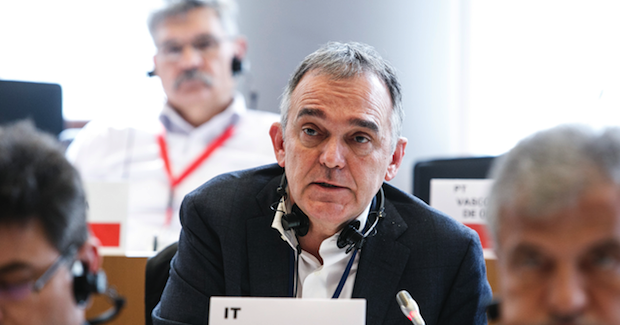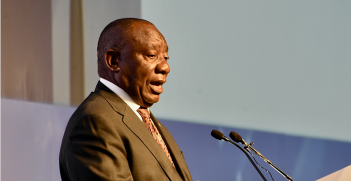New Italian Party Exposes Vulnerabilities

On the weekend, left-leaning Italian parliamentarians who had split with the government formed a new progressive political party. Italy’s ongoing political turmoil endangers Paolo Gentiloni’s government, heralds the comeback of Silvio Berlusconi to centre stage of Italian politics and raises fresh concerns on the positioning of Beppe Grillo’s 5-Star Movement.
Former Italian Prime Minister Matteo Renzi started off his political career as a self-appointed rottamatore (wrecker) of traditional politics. Last December, his defeat in a constitutional referendum wrecked his Cabinet. This month, as party secretary Renzi again lived up to his nickname by presiding over the sudden schism of the left faction from the governing Democratic Party (PD).
To begin with, the leaders of the PD’s left faction broke away from Renzi’s executive assembly and vowed to desert the next general conference to form a new parliamentary group—comprising of nearly 20 per cent of all PD’s MPs, under the control of Tuscany’s governor Enrico Rossi. On Saturday, the new party, the Progressive and Democratic Movement (DP), was founded.
Rossi leads the breakaway party, along with Roberto Speranza, the ruling party’s former parliamentary leader. In addition to the breakaway MPs, they also have the support of some of the Sinistra Italiana (the Italian Left), creating a leftist block ahead of next year’s general election.
Motivations for the split
The bone of political contention for the split was virtually all about who would challenge Renzi as party secretary, the timing of the general conference, and the composition of the caucus that would decide on preselected candidates. This shows that the deep-seated rationale of the PD’s split was purely based on power-grabbing, a ruthless fight for political leadership rather than a deliberation for grassroots policies.
Indeed, the bloody leadership fight erupted only after the Constitutional Court ruled in late January that the new electoral law introduced by Renzi in 2014 is partially unconstitutional and thus urgently needs rewriting to ensure consistency between the voting system of the lower house and that of the senate.
Before Renzi quit government, he was counting on success in the constitutional referendum to pre-empt the court’s challenge, as his proposed reform would have expanded the powers of the executive and reduced the senate to a non-elective consultative body.
However, the failed attempt of Renzi’s power grab was further sealed by the Constitutional Court slashing of his two-round ballot system, which would have favoured a single major party like PD to easily achieve a vast parliamentary majority even with a relatively low primary vote, as was Renzi’s intention.
Renzi’s troubles started well before the referendum outcome. Opinion polls showed an anti-establishment shift in the voting intentions as a consequence of the rise of Trump, Brexit and anti-EU sentiment in a politically turbulent 2016.
Thus, it became clear that Renzi’s signature electoral system and his misguided personalisation of the constitutional referendum was enabling Beppe Grillo’s 5-Star Movement to easily win government in 2018, if not earlier.
The latest opinion polls show that the PD’s splinter group could potentially gather up to 10 per cent of the votes, which may not necessarily subtract entirely from Renzi’s PD—currently polling at around 30 per cent.
At any rate, with the sinking of any prospects for a diminished PD to win back the government single-handedly, the main challenge for Renzi after surviving the schism will be to find a centrist alternative that is palatable to what remains of the PD’s moderately progressive electorate.
From obscenity to obscurity and back again
Silvio Berlusconi, a long-time admirer of Renzi’s bullish approach, is in fact discreetly courting Renzi to form a centrist grand-coalition with his party Forza Italia, which currently polls at around 12 per cent.
Berlusconi is playing a Machiavellian game to return to centre stage of Italian politics and possibly even run for government again, as he eagerly awaits the announcement that the European Court of Human Rights may scrap his parliamentary ban until 2019.
The alliance with Renzi would also return to Berlusconi the conservative centrists who broke away from Forza Italia in 2014 to support Renzi’s and then Gentiloni’s governments—a group notably including the interior-turned-foreign minister, Angelino Alfano.
In fact, Berlusconi is desperate to boost Forza Italia’s votes, as his party’s predominance in the centre-right coalition is being challenged by the steady rise of the xenophobic and anti-EU Lega Nord (Northern League), polling at 13 per cent. This plan indeed makes Berlusconi’s right-wing allies very nervous and wary of being irredeemably pushed back on the shores of political irrelevance.
On the other hand, the PD’s split is affording Beppe Grillo’s 5-Star Movement (5SM) yet another boost toward political primacy.
In the event of a Renzi-Berlusconi entente, even if the 5SM becomes the most voted party at the next elections, a centrist coalition would be poised to hold the balance of power in a likely hung parliament post-2018 (or earlier) elections.
Ultimately, it will all depend on the electoral reform to be discussed in the parliament from March and PD’s split further complicates the canvas of legislative positions in this regard.
Political deadlock
All the opposition parties save for Berlusconi’s Forza Italia—thus including Grillo’s 5SM, the Northern League and the radical left—want early elections, but do not agree on any type of electoral reform.
The risk is that no agreement will be achieved on electoral reform, thus leaving the current law as abridged by the Constitutional Court. This loosely proportional voting system is highly lopsided and thus very likely to deliver a hung parliament.
This outcome would be ominous for the future stability of the Italian political system, which seriously risks being indefinitely gridlocked as three or four bitterly divided segments.
Such a situation would further imbalance European affairs at a delicate time that will feature Brexit negotiations and general elections in the Netherlands, France and Germany.
Crucially, the only way out of this Mexican standoff in Italy’s politics would rely on the evolution of Grillo’s 5SM from an anti-establishment loose cannon into a party of government that accepts political compromise and owns a defined position in the political spectrum both in Italy and the EU.
Choosing left, centre or right, within or without the EU: the crucial factor of the next Italian elections will be the political maturity of Grillo and his passionate supporters.
Dr Giovanni Di Lieto lectures on international trade law in the Bachelor of International Business program at Monash University. His research agenda focuses on international economic law, in particular the global governance of cross-border socioeconomic relations and its repercussions on the international regulation of trade and labour markets.
This article is published under a Creative Commons Licence and may be republished with attribution.





